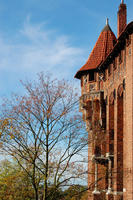You are in: Europe -> Poland -> Castle of the Teuton... , and traditional search or Image Gallery will yield results of this site only
Castle of the Teutonic Order in Malbork
| Site number: | 847 |
|
| Type of site: | Cultural | |
| Date: | 13th century | |
| Date of Inscription: | 1997 | |
| Location: | Europe, Poland, Pomeranian Voivodship (formerly Elblag Voivodship), City and County of Malbork, | |
Up to 75 images are shown here. Click on each for more details or on Image Gallery for more images.
Six official UN languages:
Arabic,
Chinese,
English,
French,
Russian,
Spanish
Other languages: Bulgarian, Czech, Dutch, German, Hebrew, Hungarian, Japanese, Norwegian-bokmål, Polish, Portuguese
Other languages: Bulgarian, Czech, Dutch, German, Hebrew, Hungarian, Japanese, Norwegian-bokmål, Polish, Portuguese
| Description: | After 1309, when the seat of the Grand Master repositioned here from Venice, this 13th-century fortified monastery (property of the Teutonic Order) was significantly enlarged and embellished. This particularly fine medieval brick castle, later plunged into decay, but was scrupulously restored in the 19th and early 20th centuries. Most of the conservation techniques that are currently acknowledged as customary were evolved here. In the Second World War is saw more severe damage and was once again restored, by means of the thorough records prepared by earlier conservators. --WHMNet paraphrase from the description at WHC Site, where additional information is available. | |
| Malbork Castle (German: Ordensburg Marienburg) was built by the Teutonic Order as an Ordensburg and named Marienburg (literally "Mary's Castle"). The town which grew around it was also named Marienburg, now called Malbork. The castle is a classic example of a medieval fortress; it is the world’s largest brick castle and one of the most impressive of its kind in Europe. The castle and its museum are listed as UNESCO's World Heritage Sites, being added to the register in December 1997. Malbork Castle is situated on the right bank of the river Nogat in Poland. It was founded by the Teutonic Knights in 1274, and was named Marienburg after the Virgin Mary, patron saint of the order. The castle is the largest fortified Gothic building in Europe, and rose to become the seat of the Teutonic Order in the 14th century. The favourable position of the castle on the river Nogat and its relatively flat surrounding allowed for easy access by barges and trading ships. During their governance of Prussia, the Teutonic Knights collected river tolls on passing ships in tandem with the other castles along the river, imposing a monopoly on the trade of amber. When the city became a member of the Hanseatic League, many Hanseatic meetings were held at Marienburg. The castle was besieged after the Battle of Grunwald, but Heinrich von Plauen successfully led its defense during the Siege of Marienburg (1410). During the Thirteen Years' War the castle was sold to King Casimir IV Jagiellon of Poland by the Bohemian king's imperial soldiers, as a substitute for their wages. Under mayor Bartholomäus Blume, the fortress resisted the Polish onslaught for an additional three years, until he himself was captured and hanged. The castle and town passed to Polish control in 1466 as part of the province of Royal Prussia. Prior to the First Partition of Poland in 1772, Malbork served as one of the several Polish royal residences. The castle was in the process of being restored to its presumed medieval appearance when World War II broke out. In 1945, the castle was over 50% destroyed as a result of fighting. The castle has since been mostly reconstructed and restoration has been ongoing since the war. However, the main cathedral in the castle, fully restored just prior to the war and destroyed during the war, remains in its ruined state. --Wikipedia. Text is available under the Creative Commons Attribution-ShareAlike License. | ||
| Source: | http://whc.unesco.org/en/list/847 | |
| Source2: | http://whc.unesco.org/en/list/847/video | |
| Reference: | 1. UNESCO World Heritage Center, Site Page. | |

































